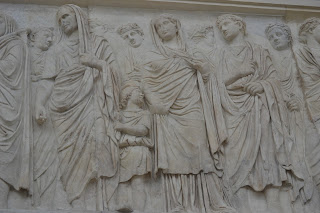One of the biggest news stories this summer regarding
clothing, was the notorious ban on the ‘Burkini’ in France. This story made me
feel fundamentally uncomfortable, having spent reasonable amounts of time in
the Middle East, I have come away an even more ardent supporter of women’s
right to wear whatever they choose
than perhaps I was before I went. I’m not denying there are issues in many
Islamic countries surrounding women’s rights, and these need to be addressed,
but the decision a women is not allowed
to dress as modestly as she may choose, simply because of her religion, is a
ludicrous one, and one that sits very uncomfortably with me. Nevertheless, the
issue has been discussed continuously over the past few months, and it is
ultimately an active debate that doesn’t need my voice added to it. What I do
hope to do in the next series of my posts however is examine the tradition of women’s
head coverings in Europe. These posts are not intended to make any judgement
either way regarding whether it is acceptable that women should or shouldn’t
veil themselves, but instead examine traditions which were very prominent until
the last century, as a reminder a woman’s choice to cover up may not be so
alien to our culture as it is often portrayed.
Ancient Rome
For my first post, I have chosen to look at Ancient Roman
traditions of wearing a veil. The Roman veil was quite different to whatever we
might imagine when we hear the word, rather than covering the face the roman
veil was more similar to a modern bridal veil, a piece of fabric fastened to a women’s
head, covering her hair, which she would have been expected to wear on any
social and public occasion.
 |
| The HBO TV Series Rome put a lot of thought into the historical accuracy of the clothing, including the veils worn by women. |
Female Modesty
Unsurprisingly, the veil was tied to the modesty of the
wearer. It is often easy to forget the frequency with which it was worn, as
many surviving roman busts depict women without the veil, instead focusing on
the elaborate hairstyle of the subject. This isn’t without cause, history of
the Western Roman Empire covers a period of nearly 1,000 years, and traditions
of dress changed significantly in this period. This included the veil, which
was not always worn strictly, nevertheless, this does not negate the importance
of women covering their head in Ancient Rome. In 166 BCE, Sulpicius Gallus
reportedly divorced his wife for going out in public with her hair uncovered,
claiming only he should see her head, and she had thus disgraced him. This
anecdote is from the Roman Republic, but the ties of the veil to modestly continue
to exist in the early empire. The Emperor Augustus consolidated his power by
claiming to restore traditional values to the empire, instituting a series of
laws surrounding public and private modesty. Augustus presented his own family
as the pinnacle of Roman tradition, and consequently his family was often (but
not exclusively) portrayed in the veil, highlighting their modesty. Later
Empresses, notably Julia Domna, wife of the Emperor Septimius Severus (who
reigned 198-211 CE) are shown with elaborate hairstyles, which are impossible
to imitate in real life. One school of thought suggests women wore wigs, which
fulfilled the same purpose as a veil, hiding their real hair in public, and
thus offering a more elaborate way of displaying their modesty.
 |
| Veiled Women on the Ara Pacis in Rome |
But What about the
Men?
Interestingly, the veil was not exclusively worn by women. Though
there was much less expectation on men to cover their head in public, when
making a sacrifice men were expected to cover their head just the same as women
were, and male priests covered their head. As a consequence of this, many
emperors would portray themselves wearing a veil to demonstrate their piety to
the gods, and dedication to the state cult. The Emperor Marcus Aurelius
(161-180 CE) depicts himself wearing a veil in a series of friezes currently on
display in the Capitoline. Augustus also portrayed himself as veiled often, and
on the Ara Pacis, a monument built by Augustus, both himself and his son in law Agrippa are shown with their heads covered, thus highlighting their civic and religious
roles in the empire.
 |
| Marcus Aurelius Veiled when performing a public sacrifice |
To Conclude…
This post barely scrapes on the vast social and political
importance of the veil in the Roman Empire. With such a sprawling period, it is
difficult to encapsulate every social change and its influence on dress.
Nevertheless, I hope this acted as a brief introduction as to why men and women
covered their hair in the Roman Empire, and in further posts I will be
examining how the tradition continued in Western Europe with the arrival of
Christianity.
Sources:
Meyers, R. 2012. ‘Female portraiture and female patronage in
the high imperial period’. In James, S.L and Dillon, S. Blackwell Companion to Women in the Ancient World
Bonfante, L and Sebasta, J.L. (eds.) 2001. The World of Roman Costume